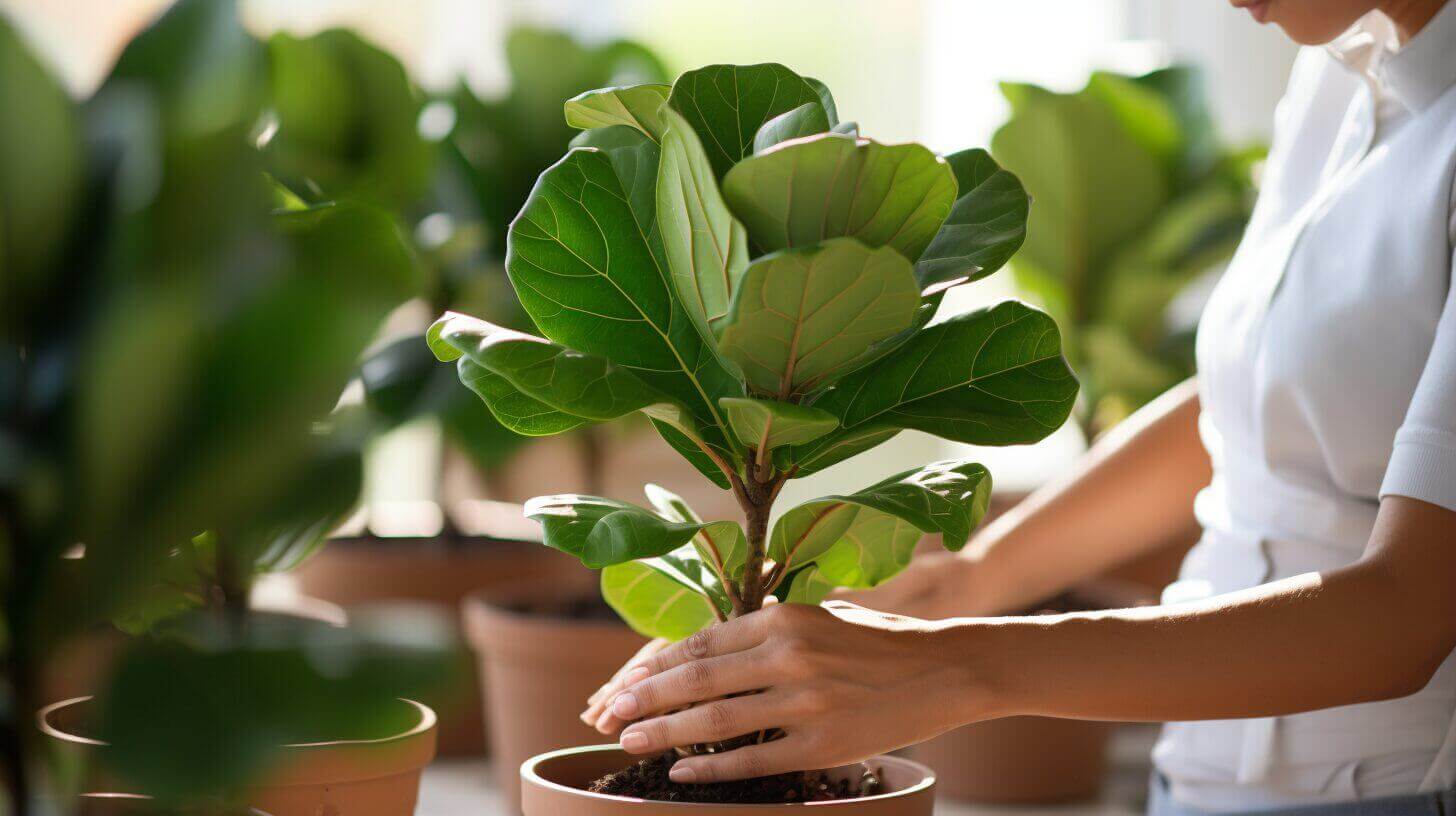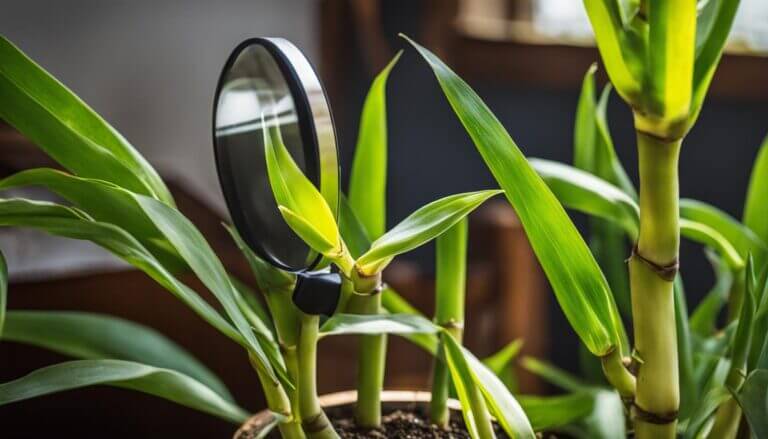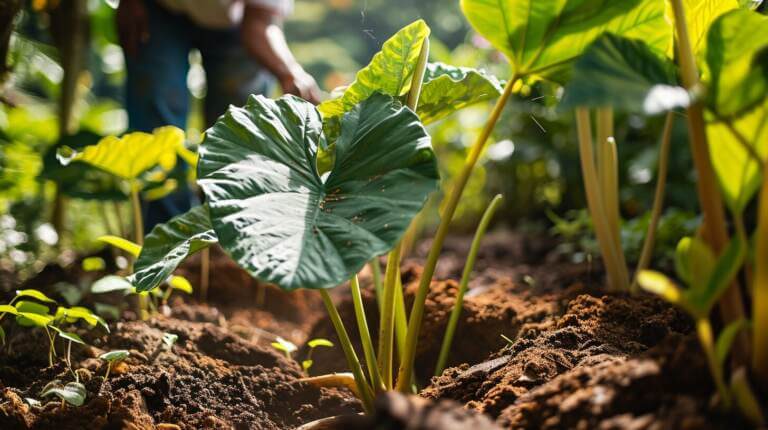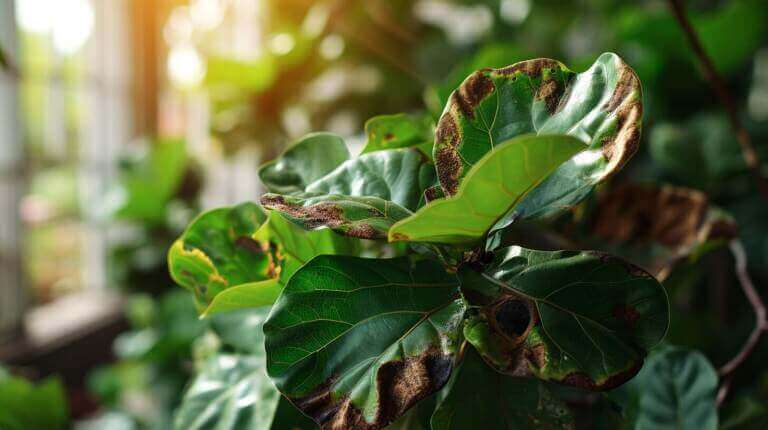How to Repot a Fiddle Leaf Fig with Root Rot: Step by Step Guide
Root rot is a common issue with fiddle leaf fig plants and can be a serious problem if not treated promptly. It is caused by overwatering and can lead to browning and dropping leaves. To prevent and treat root rot, it’s important to understand its causes and symptoms.
Key Takeaways:
- Root rot in fiddle leaf fig plants is caused by overwatering and can lead to browning and dropping leaves.
- To prevent and treat root rot, it’s important to understand the causes and symptoms.
- Root rot can be diagnosed by inspecting the roots below the surface for wet and soggy roots, waterlogged soil, and an unpleasant smell.
- To treat root rot, remove the plant from its pot, rinse the roots, remove damaged roots, and repot in fresh soil with good drainage.
- Signs that your fiddle leaf fig needs repotting include roots growing out of the pot, roots on top of the soil, a mostly root-bound root ball, and faster soil drying.
What Causes Root Rot in Fiddle Leaf Fig Trees
Root rot is a common issue that affects fiddle leaf fig trees. It occurs when there is an accumulation of moisture in the soil, typically due to overwatering. The excess water prevents the roots from receiving enough oxygen, leading to the development of root rot. Additionally, a lack of proper drainage in the pot can contribute to the problem, as water becomes trapped in the soil and cannot escape.
When a fiddle leaf fig is overwatered, the excess water saturates the soil, creating a damp environment that is ideal for fungal and bacterial growth. These pathogens attack the roots of the plant, causing them to decay and ultimately leading to root rot. Over time, the roots become mushy and unable to perform their vital functions of absorbing water and nutrients.
To prevent root rot in fiddle leaf fig trees, it is essential to maintain a proper watering routine. Allow the top inch of soil to dry out before watering the plant again, and ensure that the pot has adequate drainage holes to allow excess water to escape. Choosing a well-draining potting soil mix can also help prevent water from becoming trapped in the soil.
It is important to note that root rot can also be caused by other factors, such as using contaminated potting soil or having a pot that is too large for the plant. Regularly inspecting the roots and taking prompt action at the first sign of root rot can help save your fiddle leaf fig and prevent further damage.
The causes of root rot in fiddle leaf fig trees can be summarized as follows:
- Overwatering: Excess moisture in the soil prevents the roots from receiving enough oxygen, leading to root rot.
- Lack of drainage: If the pot does not have adequate drainage holes, water can become trapped in the soil, contributing to the development of root rot.
- Fungal and bacterial pathogens: Overwatering creates a moist environment that is favorable for the growth of pathogens, which attack the roots and cause decay.
- Contaminated potting soil: Using contaminated soil can introduce pathogens that can lead to root rot.
- Pot size: Using a pot that is too large for the plant can result in excess moisture in the soil, increasing the risk of root rot.
How to Diagnose Root Rot in a Fiddle Leaf Fig
Diagnosing root rot in a fiddle leaf fig can be challenging as the symptoms may not be immediately visible on the plant’s leaves. However, by inspecting the roots below the soil surface, you can accurately determine if your plant is suffering from root rot. Look for the following signs:
- Wet and soggy roots: Healthy roots should be firm and white, but if they appear soft, slimy, or discolored, it is likely an indication of root rot.
- Waterlogged soil: The soil around the roots may feel excessively wet and fail to drain properly due to the accumulation of excess moisture.
- Unpleasant smell: Root rot often causes a foul odor in the soil or around the roots, which can be an unmistakable sign of the condition.
If you notice any of these signs, it is crucial to take immediate action to treat the root rot and save your fiddle leaf fig plant.
While these symptoms are indicative of root rot, it’s recommended to confirm the diagnosis by gently removing the plant from its pot. Carefully examine the roots, paying close attention to their color, texture, and smell. Healthy roots should be white, firm, and emit a mild earthy scent. If you observe mushy or dark-colored roots, it confirms the presence of root rot.
Diagnosing root rot early is essential for successful treatment and the long-term health of your fiddle leaf fig. By addressing the issue promptly, you can provide the necessary care and prevent further damage to your beloved plant.
How to Treat Root Rot on Fiddle Leaf Fig Trees
If you’ve discovered root rot in your fiddle leaf fig tree, it’s important to take immediate action to save your plant. Treating root rot involves a series of steps to remove the damaged roots, provide proper drainage, and promote healthy growth.
Step 1: Remove the plant from its pot
“Gently remove your fiddle leaf fig from its pot, being careful not to damage the roots further. Shake off excess soil and inspect the roots for signs of rot. Trim away any mushy or discolored roots using a clean pair of shears or scissors. This will help prevent further spread of the infection.”
Step 2: Rinse the roots
“After removing the damaged roots, give the remaining healthy roots a thorough rinse under running water. This will help remove any remaining soil and reduce the chances of reinfection. Allow the roots to dry out for a few hours before proceeding to the next step.”
Step 3: Repot in fresh soil
“Choose a new pot with good drainage and fill it with a well-draining potting soil mix. Create a small mound in the center of the pot and carefully place the fiddle leaf fig on top, spreading out the roots. Fill in the gaps with more soil, ensuring that the plant sits at the same depth as before. Water the plant thoroughly, allowing the excess water to drain away.”
Step 4: Adjust watering and monitor
“To prevent future root rot, it’s crucial to adjust your watering routine. Fiddle leaf figs prefer a slightly drier environment, so make sure to let the soil dry out between waterings. Avoid overwatering and check the moisture level in the soil with your finger. Additionally, keep an eye on your plant for any signs of stress or recurrence of root rot.”
By following these steps, you can effectively treat root rot in your fiddle leaf fig and give it the best chance of recovery. Remember to provide proper care and monitor your plant’s condition to ensure its long-term health.
Signs that Your Fiddle Leaf Fig Needs Repotting
If you’ve noticed some changes in your fiddle leaf fig plant, it may be time for a repotting. Here are some signs that indicate your fiddle leaf fig needs repotting:
- Roots growing out of the bottom of the pot: When the roots start poking out of the drainage holes, it’s a clear sign that your fiddle leaf fig has outgrown its current pot.
- Roots on top of the soil: If you see roots crawling across the surface of the soil, it means that the root system is becoming overcrowded and needs more space.
- Mostly root-bound root ball: When you take the plant out of its pot and find a tangled mass of roots taking up most of the pot’s space, it’s a definite indication that repotting is necessary.
- Soil drying out faster than usual: If you find that your fiddle leaf fig’s soil is drying out much more quickly than it used to, it could be a sign that the root system has become too large for the pot, and there’s not enough soil to retain moisture.
It’s important to keep an eye out for these signs and address them promptly to ensure the long-term health and well-being of your fiddle leaf fig.
Table: Signs of Repotting
| Signs | Explanation |
|---|---|
| Roots growing out of the bottom of the pot | Indicates that the plant has outgrown its current pot. |
| Roots on top of the soil | Suggests that the root system is becoming overcrowded and needs more space. |
| Mostly root-bound root ball | Shows that the roots have become tangled and take up most of the pot’s space. |
| Soil drying out faster than usual | Could be a result of the root system outgrowing the pot, leading to insufficient soil moisture retention. |
By repotting your fiddle leaf fig when these signs are present, you can provide it with the space and nutrients it needs to continue thriving. Repotting is an essential part of fiddle leaf fig care and should be done every 1 to 2 years, or when these signs become apparent.
FAQ
How do I repot a fiddle leaf fig with root rot?
To repot a fiddle leaf fig with root rot, remove the plant from its pot, rinse the roots, and remove any damaged ones. Repot the plant in fresh soil with good drainage, water thoroughly, and wait for the soil to dry out before watering again.
What causes root rot in fiddle leaf fig trees?
Root rot in fiddle leaf fig trees is caused by overwatering and a lack of drainage in the pot. It results in an accumulation of moisture in the soil, leading to soggy roots and potential damage.
How do I diagnose root rot in a fiddle leaf fig?
To diagnose root rot in a fiddle leaf fig, inspect the roots below the surface. Signs of root rot include wet and soggy roots, waterlogged soil, and an unpleasant smell in the soil or around the roots.
How do I treat root rot on fiddle leaf fig trees?
To treat root rot on fiddle leaf fig trees, remove the plant from its pot, rinse the roots, and remove any damaged or mushy roots. Repot the plant in a new container with good drainage and fresh, fast-draining soil. Avoid overwatering and wait until the roots have dried out before watering again.
What are the signs that my fiddle leaf fig needs repotting?
Signs that your fiddle leaf fig needs repotting include roots growing out of the bottom of the pot, roots on top of the soil, a mostly root-bound root ball, and soil drying out faster than usual.
How do I repot a fiddle leaf fig step by step?
To repot a fiddle leaf fig step by step, remove the plant from its pot, loosen up the root ball, inspect the roots, remove any damaged ones, choose a new pot with good drainage, fill it with a well-draining potting soil mix, place the plant in the new pot, fill it with soil, leaving some space at the top, water the plant thoroughly, and wait for the soil to dry out before watering again.
What are the best tips for repotting a fiddle leaf fig?
Some tips for repotting a fiddle leaf fig include using a pot with drainage holes, selecting the right pot size, choosing a well-draining potting soil mix, ensuring the plant gets enough light, and providing proper care after repotting.
Can a fiddle leaf fig recover from root rot?
If caught early and treated promptly, a fiddle leaf fig can recover from root rot. By rinsing the roots, removing any damaged ones, and repotting in fresh soil, the plant has a good chance of survival. It’s important to provide proper care, including sufficient light and appropriate watering, to help the plant stabilize and recover.







